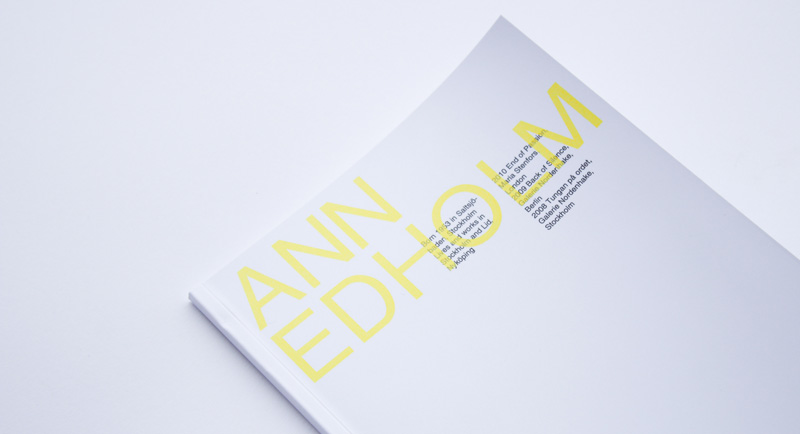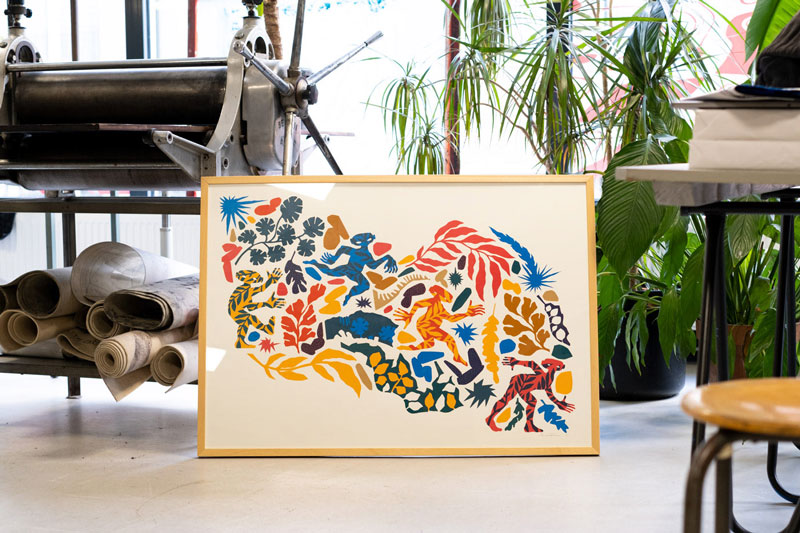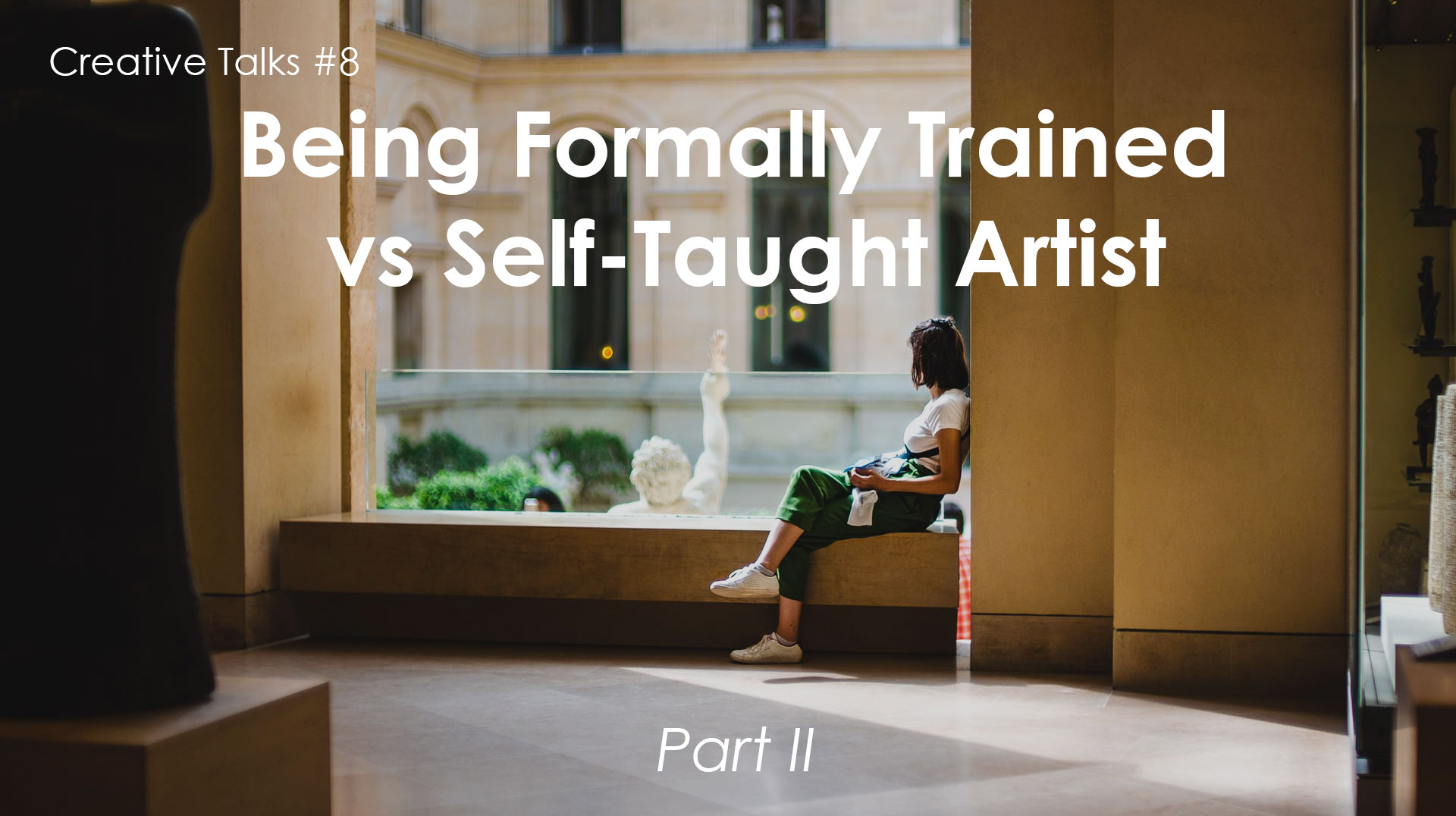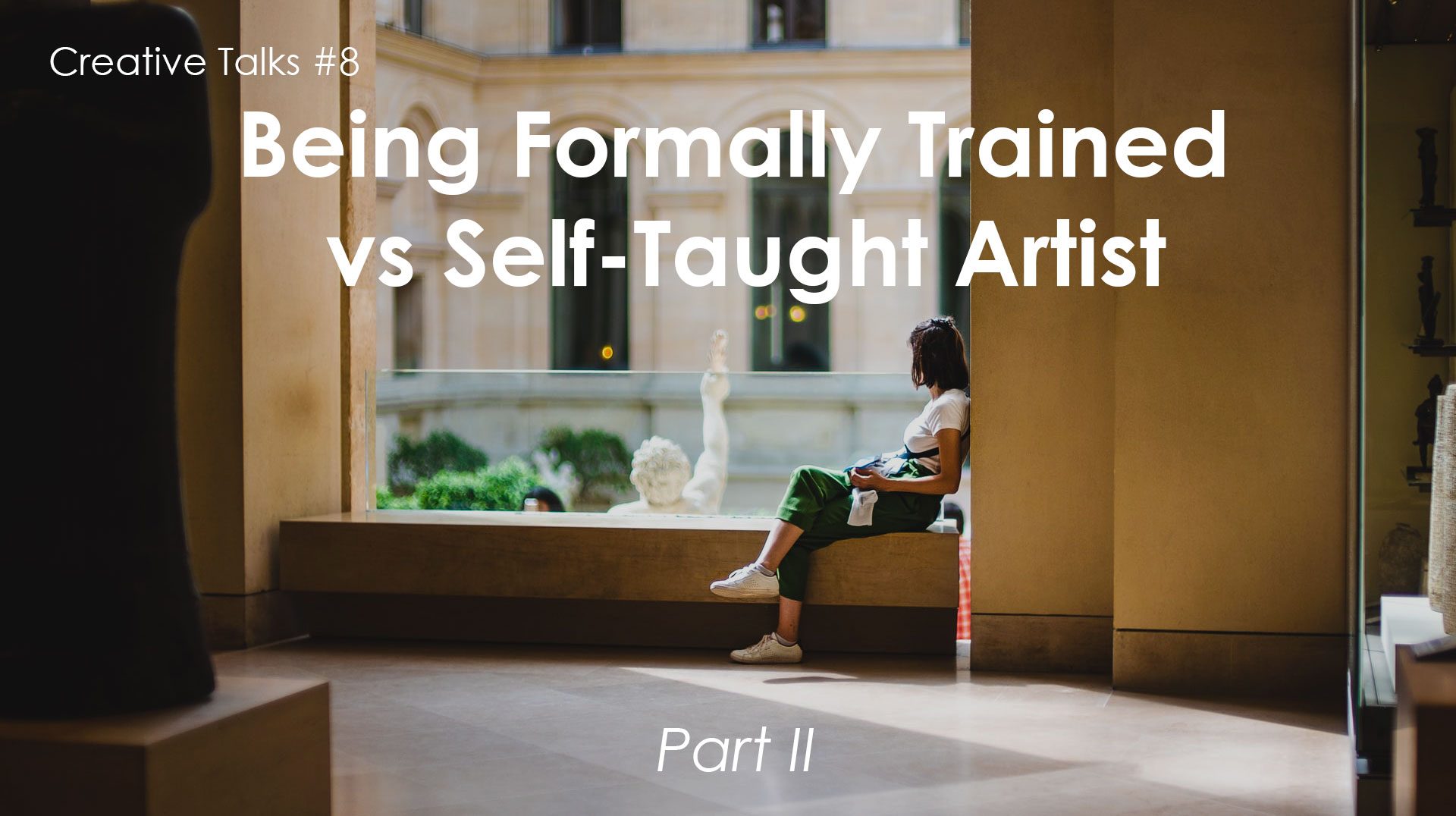Have you ever wondered if you’ve chosen the right path in life? I certainly have! But the other thing that makes me question my career even more is what if I’ve gone to art school instead of learning everything on my own.
Regardless of how self-centered these questions might sound, many people find themself in the same position as I do. So it’s only wise to ask the experts in the field to share their experience and industry insights to help us detangle the right choice, and this is what we are going to cover in this month’s Creative Talks.
We’ve asked creatives from around the world the following questions:
- Are you a formally trained or self-taught artist? Tell us a story of learning your craft.
- In your opinion, what are the major pros and cons of being formally trained or self-taught?
- Which path do you think the novice creatives should take and why? Do you have any advice for beginners?
Did you know that Creative Talks is a monthly topic powered by Approval Studio? Well, now you do. In this section of our blog, we gather valid opinions and helpful tips from experts in the design and art spheres regarding various topics. Some of the previous entries include things you shouldn’t do while working with designers and why creatives love their job (Part I and Part II).
In case you’ve missed the first part of this article, it’s right here: Part I.
Table of contents:
Nidia Dias – Art Director & Designer
Nidia Dias’ Website and Behance
I would say I’m both formally trained and self-taught! I’m officially trained in graphic design but self-taught in 3D, and most of my motion graphics learning is also self-taught. My career path was always based on my curiosity and the need to get a step further. When I imagined myself being a graphic designer, I wanted to do album covers and cool posters. Once I started doing those, I’ve asked myself, “Wouldn’t it be cool if this could move?” And that’s been my approach since then!
Being formally trained means you have someone to rely on for questions and to guide you. But on the other hand, being self-taught makes you question things and pushes you to find your own answer. It’s tough to say which path beginners should take. I like having that background in graphic design, and it helped me push and evolve further my aesthetics. If anything, I would suggest that nowadays there are so many affordable online courses that people can do at their own pace! I think that’s kind of the best of both worlds 😉
Desislava Danova – Product & Graphic Designer
Desislava Danova’s Behance and Instagram
I would have to say I am both formally trained and self-taught. My official degree is in Product Design; however, I am currently working as a Graphic Designer. Once I graduated with my Bachelor’s degree, I realized that I was much more interested in graphic design, so I started looking for other creatives and studios that inspired me and tried to understand the mood and reasoning behind their work. I further learned about the field through actual work in studios and bettered myself as I go.

It all depends on the individual and your way of learning. However, for me, design is, on the one hand, hard skills, such as knowing programs, color theory, history of typography, etc. And on the other hand, (personally the most important one) are the soft skills such as learning how to conceptualize, analyze and deeply understand the issue so that you could provide an appropriate solution.
Learning hard-skills in our day and age is incredibly accessible and easy, whether online videos, books, or courses. However, in formally trained scenarios, you can meet great, inspiring people who can mentor you along the process and develop your critical thinking and passion for the field of design.
Whether it is a university or a self-taught approach, either way, it works depending on a person’s learning methods. I would recommend searching for other professionals or individuals that you aspire to be like someday. Follow and analyze their work, try to delve deep into their projects truly, not only in the aesthetic surface but examine the meaning of their work, why they came up with those solutions. My biggest advice is to learn to think, question, and constantly remain curious about what is happening not only in the design field but all over the world. The rest will come with time and practice.
Ognjen Gligorijevic – Graphic Designer & Art Director
Ognjen Gligorijevic’s Website and Behance

I believe that there’s no big difference between formally trained or self-taught artists; they’re equally fantastic. Even though I am formally trained, I went to art high school to study graphic design, and then I studied graphic design at university. I think that formal education is easier than the self-taught route since it is already structured to help us. Even when we are not motivated, we still do the thing we’re supposed to do. While if you want to go with a self-taught route, you will need more energy and more motivation since it’s easier to quit.
Pros of formal education are that you can establish lasting and mutually beneficial relationships easier, but the con is that it can get pretty expensive. There’s no right or wrong way. It just depends on the person and what works best for them. My advice for beginners is that no matter what route they choose to take, they should have a clear plan and set of goals they want to accomplish even in the beginning, formal education or not. Work smart, have a structured program, and stay motivated!
Bernardo Abreu – Illustrator & Designer
Bernardo Abreu’s Behance and Instagram
I am actually a bit both formally trained and self-taught. As a son of architects, design and illustration have always been part of my life. Drawing was probably my favorite plaything growing up, and I was lucky always to have lots of paper and other materials at home. We also used to have computers and some design software, which was not so common in early 90s Brazil.
I spent some time avoiding college, believing I would fare better as a self-taught artist. Thankfully I grew out of that phase and got a degree in graphic design. Although my course had — in my vision — a truckload of flaws (one of which was the huge student loan I had to take), I did learn a lot from it, especially about how to navigate my profession. That said, I consider myself formally trained in a very basic way, as I didn’t specialize myself in one aspect of design or illustration, academically speaking.

I’d say the biggest con of seeking formal training is, at least in my country, that it’s very costly. This imbues the profession with a great deal of privilege, as in you most certainly gotta have some financial comfort, to begin with, if you’re planning to study design. We do have excellent public design schools for free, but the process of getting in is so ludicrously competitive that they’re usually reserved for the most affluent students anyway. That can be said for the design and illustration industry in Brazil as a whole (maybe the world?). The way I see it, the time you have to take to fully develop as an artist is pretty much incompatible with paying your bills, which favors individuals who don’t have to worry as much about money, giving them the tools to grow. At the same time, less privileged professionals are too busy working their asses off to have that opportunity.
As for the concept of self-teaching, I think we should be very careful with the image it conjures. In my opinion, there is no “true” self-teaching. You’re constantly absorbing your knowledge from somewhere and ultimately from someone (unless you’re a caveman, that is). The difference being that that source can be easier or harder to decipher. Studying the work of great painters by yourself is valid, although very hard to decode properly. On the other hand, formal education is designed to be really easy to decipher, which will save you a lot of time. The great thing about formal education for me is that, if it’s good, it teaches you how to learn. I think that’s the most valuable piece of knowledge. Everything else (technique, training, experience) is easy, although it may require some patience.
First: I am a firm believer in education. Go to school, get in touch with people that have valuable things to teach, stay close to colleagues and teachers that you admire, collaborate, get involved in projects. If it seems prohibitive for you in terms of money, make it your objective: try to find cheaper alternatives, apply for a scholarship, get a loan, just don’t give up, or turn your back on knowledge. It enables you to grow.
Second: don’t worry about tools. Tools are easy once you know what you want to do. Photoshop, fancy drawing materials, etc., you don’t depend on them; the ability to design is in you, not in objects or software. Also, the industry standard is constantly changing. Someone whose knowledge is based on the operation of tools is at serious risk of getting obsolete.
This leads us to the third and last thing: drawing is super easy. Really. The difficult part is seeing. The most important part of my formation was probably studying drawing and painting, which for me meant doing a ton of observational drawing exercises using a lot of different media and techniques under the tutelage of a professor; then discussing composition, the use, and characteristics of materials, and the work of other artists. Observational drawing is never too much. Do it like crazy until you get good at it.
By the way, if you happen to work with a lot of design projects at once, online proofing tools are here to help you. It assists with managing your workflow and ensures headache-free artwork approval. Approval Studio, for example, offers on-image annotations, comprehensive reporting, compare modes, and so much more.
Josefina Schargorodsky – Illustrator
Josefina Schargorodsky’s Website and Behance
I am formally trained – or at least a bit formally trained. After high school, I signed myself up in art school to study Fine Arts. After a year, I realized I didn’t like that and changed my degree to Fashion and Textile Design. So I did go to college but studied something a little different from what I do now. Fashion design gave me a lot of design training, and ultimately I learned a lot about textiles which was the way I entered the illustration world. At the same time, I did (and still do) many illustration courses too. That gave me the knowledge to get better at my work.

I think that when you are formally trained, you have a better understanding of presentation, deadlines, and showing your work a certain way. If you study design, you get your mind working in a certain process-way that can’t be undone. Saying that when you are self-taught, I think you have more freedom, you are not conditioned so much by outside opinion and validation, and you find your own path, which can lead you to a unique style.
I don’t think there is a right way to do this. I believe that not everyone is made for formal academy education, and that is ok! I would advise beginners to try different paths and see what works for them. Maybe you try college, and you struggle with it, don’t worry! Try something different! There is no right way to be an artist, so there is not a certain path to follow that will make you successful at it.
Anna Haury – Graphic Designer & Illustrator
Anna Haury’s Behance and Instagram
Well, you could say that my education is actually very formal. Because I had been drawing my whole young life, I started art school when I was 14 and graduated at the age of 19, then did another additional year in communication design. I know that many people are biased against art schools, but it was definitely the right choice for me. It gave me the chance to move from the countryside to somewhere that back then seemed like a big city, and I got to learn a craft at such a young age which remains to this day to be my passion and even pays my bills. So, lucky me! But it’s definitely not for everyone.

I feel that whatever the path, both outcomes can be equally professional and strong. Let’s put it like that: For someone that is trained formally, it will maybe take more time finding their very own style. I often see distinctive aesthetics permeating a whole school or design course, which is not a bad thing at all because, especially as a beginner, you want some guidance. Still, with time you need to part from this and develop something original.
On the other side, autodidacts may have a harder time collecting all the necessary information on design theory. As I see it, the internet often only provides bits and pieces on, e.g., the broad field of typography, so you’d really need to dive into that and buy books or online courses to extend your knowledge. But that is just part of the process, and even though something can seem like a lot at first, it’s good to start somewhere and remain interested! Things tend to seem way smaller and less frightening as soon as we know something about them.
In my opinion, choosing the path for you depends on whether you want to focus on a specific field like, e.g., illustration, or if you want a broad knowledge in, e.g., graphic design, which includes getting to know functions of various programs, typography, printing techniques, layouts, and much more.
In the first case, I would recommend taking your time and practice to develop something unique and close to your heart. There are various tips and tricks to find online, and you won’t necessarily need a teacher. On the other hand, for the second example, I think it’s good to have professional guidance, learn the basics, and get feedback.
But as always: trust your guts! Someone’s path might not be the right one for you. Art is all about being yourself and finding your very own way and niche.
Nick Liefhebber – Illustrator & Designer
Nick Liefhebber’s Website and Behance

I studied graphic design at the University of the Arts Utrecht, which taught me a lot about finding and telling stories. Since the world is evolving all the time, I think every designer or artist is partly self-taught. You have to keep up to date with the world, and you can’t keep making the same stuff over and over again. I learned to illustrate myself and not in art school. I was looking for a way to create images I didn’t have to explain to a client. Now that’s also a big part of my professional work.
I think the most significant pro of being formally trained is the theoretical and conceptual part of working as a designer or artist. You have to find your style yourself, and techniques change and evolve. When you’re self-taught, you can focus on what inspires you and find your voice. I think it’s more challenging, though, and the best way to evolve is in the middle of these two. Learn from the professionals and past, and then take that to find your own direction.
That’s really hard to give a piece of advice, and art education can be very different all around the world. People are saying they learned nothing important in art school and people who were very inspired by it. But if you’re starting out, the best thing you can do is just keep creating, putting it out into the world, and learning. Don’t be afraid to experiment and try new things. It can feel safe if you found a certain style or subject but stepping out of that now and then can improve your work.
Konrad Sybilski – Brand & Graphic Designer
Konrad Sybilski’s Website and Instagram
I studied graphic design at the Polish-Japanese Academy of Information Technology.
Also, I focused on drawing and illustration after the first course, and I switched my focus to graphic design after finishing the university. Today I’m an independent brand designer. What I do is create and transfer values into building brands. So I work not only in visual fields like identity design or packaging but also in strategy and naming.
The obvious advantage of art education is that someone introduces you to the basics to achieve early development very quickly. Thanks to this, you can easily get to know many different tools, both traditional and digital, which may become your main working tools in the future. What’s more, an art university can give you a lot of theory and teach you a certain kind of thinking, allowing you to use this knowledge many years after graduating from the university.

The main downside is that your growth can stop being ‘organic.’ Some absentees take the school heritage, its main style, its way of thinking so deeply to heart that they lock themselves in creating similar things and have difficulties going beyond it. The outcome isn’t something that comes directly from them, but more what they soaked up in school.
However, I haven’t gotten to the main advantage of the university yet. And in my opinion, this is meeting interesting people. The people from whom you will be able to learn and inspire and who, thanks to personal contact, will be able to create an environment in which you will be able to develop as a creator even years after graduating from university. Besides, studying at an art school is an enjoyable time.
I‘m lucky to know a lot of great designers personally. Some of them are working after art schools, some of them don’t. So, in my opinion, if there is one good way to be excellent is to be passionate about your work and to practice as much as you can. You need to meet new challenges, new projects, new things to grow. You need to learn from others. Try to draw from the environment you are in. Not only from art teachers but also your boss, your colleagues, people you follow on Instagram, even your clients can be your ‘art masters.’ It is vital to have a desire for knowledge from everywhere: Internet, books, courses, exhibitions, the whole world. The entire life is the educational process. So you need to be always self-taught, even if you are in art school. Be open, be passionate, and do your thing!
Final Thoughts
First of all, I would love to express my unlimited gratitude to all of the creatives who shared their experience and thoughts with us. They are beyond helpful and reassuring! For even more wonderful opinions on what it’s like to be formally trained or self-taught, check Part I right here.
As it turns out, most of the designers and artists are actually a mixture of both being formally trained and self-taught. And if I’m being perfectly honest, it makes so much sense! While formal education provides you with an undeniably strong basis and knowledge in the industry, learning and exploring independently broadens the horizons for experiments and self-search. So it’s only fair that most of the creatives identify themselves with both of the worlds.
And if you would like to share your own story or get featured in our next article, please contact us here or via [email protected]. We love hearing from you!
Have a great one!

 TEAM SOLUTIONS
TEAM SOLUTIONS WORKFLOW SOLUTIONS
WORKFLOW SOLUTIONS



 REVIEW TOOL
REVIEW TOOL PROJECT MANAGEMENT
PROJECT MANAGEMENT TOOLS & INTEGRATIONS
TOOLS & INTEGRATIONS
 CLIENT INTERVIEWS
CLIENT INTERVIEWS









